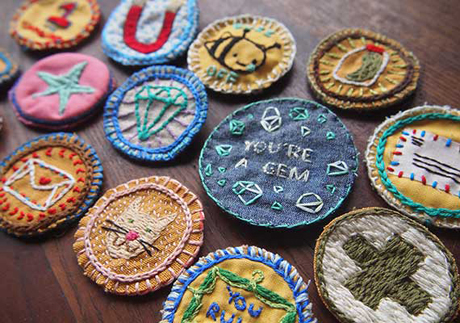Lavinia Fontana was born August 24, 1552, in Bologna, Italy.
Lavinia Fontana was one of the most successful painters in her time, and the highest rated female painter in Bologna. Unlike the few other women artists at the time, she had a prolifically successful career painting a wide range of subjects for her patrons and clients -- including portraits, alterpieces and historical and mythological paintings.
While it wasn't totally uncommon for noblewomen to explore artistic pursuits, the level of training and support, as well as the number and types of commissions she received during her career, are remarkable. It was a lucky accident that she was born into the family and time she was. Her father, Prospero Fontana, was himself an accomplished and well respected artist of his time. He taught his daughter and treated her as an apprentice in the family business of painting, which was customary at the time.
In addition to having a master as a father and mentor, she was born during an exciting time for art in Bologna. The city was considered one of the greatest cities for painters at the time. She was surrounded by great artists and art, and there is no doubt that the social and religious culture of Bologna had a profound effect on her as an artist.
When she was twenty-five, she married another young student of her father, Paolo Zappi. She and Paolo had 11 children, only three of whom survived her. Although Paolo was also a painter, it appears that his role in the marriage was more one of support for his wife's artistic career. He acted as her assistant, which included painting minor elements of her works.
Her commercial painting included more than just portraits. She also painted devotional images and alterpieces.
Her fame attracted the attention of high ranking members of the Catholic Church, and she was increasingly commissioned for portraits and works with a religious theme.
 |
| Lavinia Fontana, 1552-1614, Bolognese Painter by Felice Antonio Casone ca. 1611 (source: Wikipedia) |
Lavinia Fontana was one of the most successful painters in her time, and the highest rated female painter in Bologna. Unlike the few other women artists at the time, she had a prolifically successful career painting a wide range of subjects for her patrons and clients -- including portraits, alterpieces and historical and mythological paintings.
While it wasn't totally uncommon for noblewomen to explore artistic pursuits, the level of training and support, as well as the number and types of commissions she received during her career, are remarkable. It was a lucky accident that she was born into the family and time she was. Her father, Prospero Fontana, was himself an accomplished and well respected artist of his time. He taught his daughter and treated her as an apprentice in the family business of painting, which was customary at the time.
 |
| Self-portrait at the Clavichord with a Servant ca. 1577 (source: Wikipedia) |
In addition to having a master as a father and mentor, she was born during an exciting time for art in Bologna. The city was considered one of the greatest cities for painters at the time. She was surrounded by great artists and art, and there is no doubt that the social and religious culture of Bologna had a profound effect on her as an artist.
Being born the daughter of the successful artist Prospero Fontana (1512-1597), a provincial painter with a solid reputation, had numerous advantages. During Lavinia's apprenticeship, Prospero shared with his daughter the artistic skills he had mastered during his early training in Genoa. The time Prospero had spent working in Florence and Rome, prior to returning to Bologna, undoubtedly contributed to the overall quality of Lavinia's early studies. Lavinia's apprenticeship in her father's studio provided her with ample opportunities to contribute to her father's commissioned works as well as to produce works of her own design. The first recorded works attributed to the hand of Lavinia date from 1575. Lavinia also profited from being born in the Italian city--state of Bologna, which was a prominent Italian artistic center during her lifetime. In Bologna, Lavinia could study distinguished works of art at her convenience.Under her father's tutelage she developed her natural talent and became a prosperous portrait painter. At the time, most women painters worked solely selling their skills painting portraits of wealthy families, and particularly women nobility. Her attention to detail and her genuine talent brought her widespread fame, reaching beyond Italy.
(source: Extraordinary Women of the Medieval and Renaissance World: A Biographical Dictionary, by Carole Levin; Debra Barrett-Graves et al.)
 |
| Portrait of a Noblewoman ca. 1580 (source: NMWA) |
When she was twenty-five, she married another young student of her father, Paolo Zappi. She and Paolo had 11 children, only three of whom survived her. Although Paolo was also a painter, it appears that his role in the marriage was more one of support for his wife's artistic career. He acted as her assistant, which included painting minor elements of her works.
Her commercial painting included more than just portraits. She also painted devotional images and alterpieces.
Fontana was also the first woman to paint alterpieces at the time of Counter-Reformation and the growing power of the Catholic Church. One of her altarpiece paintings, San Francisco di Paola blessing the Child has been also on view in the Pinacoteca Nazionale. Birth of the Virgin Mary can be seen in Santissima Trinita church and Madonna Enthroned with Child and Santa Caterina of Alexandria, Cosma, Damiano e il Committente Scipione Calcina in the church of San Giacomo Maggiore, among other churches of Bologna.
(source: Women In The Arts)
 |
| Judith with the Head of Holofernes ca. 1570 (source: It's About Time) |
Her fame attracted the attention of high ranking members of the Catholic Church, and she was increasingly commissioned for portraits and works with a religious theme.
National Gallery of Art Fontana and her family moved to Rome in 1603 at the invitation of Pope Clement VIII. She gained the patronage of the Buoncompagni, of which Pope Gregory XIII was a member. Lavinia thrived in Rome as she had in Bologna and Pope Paul V himself was among her sitters. She was the recipient of numerous honors, including a bronze portrait medallion cast in 1611 by sculptor and architect Felice Antonio Casoni.There are quite a few great resources online and in print if you're interested in learning more about the life and works of Lavinia Fontana:
(source: Wikipedia)
- Extraordinary Women of the Medieval and Renaissance World: A Biographical Dictionary, by Carole Levin; Debra Barrett-Graves et al.
- Lavinia Fontana: A Painter and Her Patrons in Sixteenth-century Bologna, by Caroline P. Murphy
- National Museum of Women in the Arts
- Women in the Arts
- 3 Pipe Problem
- Uffizi Gallery






















